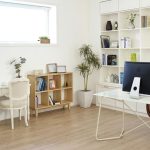So, you've set up your home office, ready to conquer the day, but the glare from your screen is making you feel like you're staring into the sun.
Fret not, for there are simple yet effective ways to combat this pesky problem. From adjusting your monitor position to choosing the right window treatments, there are several strategies you can implement to create a glare-free workspace.
Stick around to discover how you can make your home office a haven of productivity without the glare getting in your way.
Key Takeaways
- Position your monitor perpendicular to windows or light sources to reduce glare and eye strain.
- Use an anti-glare screen protector to protect your eyes and minimize screen glare.
- Control natural light sources by using window coverings and adjusting furniture placement.
- Regularly clean and maintain blinds to effectively reduce glare and block excessive light.
Adjusting Monitor Position
To reduce screen glare in your home office, position your monitor so that it's perpendicular to any windows or light sources in the room. This means placing your monitor at a right angle to the windows or light sources rather than directly in front of or facing them. This simple adjustment can make a big difference in reducing glare and minimizing eye strain.
Another important aspect of adjusting your monitor position is the tilt. The top of the monitor should be slightly below your eye level. This helps in preventing neck strain and reduces the amount of light that reflects off the screen into your eyes. Adjust the tilt of your monitor so that you can comfortably see the entire screen without having to tilt your head up or down.
In addition to positioning and tilt, the distance from your eyes to the monitor is crucial. Ideally, your monitor should be about an arm's length away from you. This distance helps in reducing eye fatigue and strain. If the monitor is too close, you may experience discomfort and if it's too far, you might find yourself squinting or leaning forward, which can lead to posture issues.
Using Anti-Glare Screen Protectors
Consider using an anti-glare screen protector to reduce screen glare and protect your eyes while working in your home office. Anti-glare screen protectors are designed to minimize the amount of light reflecting off the screen, which can help reduce eye strain and discomfort caused by screen glare. These protectors incorporate anti-glare technology, such as matte finishes and coatings, to diffuse reflections and minimize the impact of direct light sources.
Here's a quick comparison of some popular anti-glare screen protectors to help you make an informed decision:
| Brand | Size | Compatibility | Features |
|---|---|---|---|
| Tech Armor | 15.6 inches | Laptops, monitors | Matte finish, scratch-resistant coating |
| SightPro | 24 inches | Monitors | Anti-glare coating, blue light filter |
| ANTOGOO | 13 inches | MacBook Air, MacBook Pro | Anti-scratch, anti-fingerprint, easy installation |
| FORITO | 21.5 inches | iMac, desktop monitors | 5H hardness coating, bubble-free installation |
When selecting an anti-glare screen protector, consider the compatibility with your device, the size of the screen, and any additional features that may benefit your specific needs. By investing in an anti-glare screen protector, you can significantly improve your screen glare reduction and create a more comfortable and productive work environment in your home office.
Controlling Natural Light Sources
Hey there!
Now let's talk about how to control natural light sources in your home office.
You can start by using window coverings like curtains or blinds to adjust the amount of light coming in.
Also, consider positioning your furniture in a way that minimizes direct sunlight on your screen.
Don't forget to make use of blinds or shades to regulate the intensity of natural light.
Window Coverings
You may want to consider using blackout curtains or blinds to effectively control natural light sources and prevent screen glare in your home office. Here's why they can be beneficial:
- Material: Look for curtains or blinds specifically designed for glare reduction, such as those made with light-blocking materials.
- Adjustability: Opt for window treatments that allow you to easily adjust the amount of light entering the room, giving you flexibility based on the time of day and your specific needs.
- Aesthetic: Consider the aesthetic appeal of the curtains or blinds to ensure they complement your home office décor while serving their practical purpose.
Positioning of Furniture
Position your furniture so that natural light sources, such as windows and overhead lighting, aren't directly causing screen glare on your workspace. Consider your furniture arrangement and workspace layout to minimize the impact of natural light on your screen.
Place your desk in a position where the light source isn't directly behind or in front of it. This will help reduce the glare on your screen. If possible, position your desk perpendicular to the windows to minimize glare.
You can also consider using blinds or curtains to control the amount of natural light entering the room.
Use of Blinds
Controlling the amount of natural light entering your workspace can be effectively achieved by using blinds or curtains. When it comes to using blinds to prevent screen glare, here's what you need to know:
- Blinds Maintenance
- Regularly dust and clean blinds to ensure they function properly and effectively reduce glare.
- Check for any damage or wear and tear that may affect their ability to block out light.
- Blinds Customization
- Consider installing adjustable blinds that allow you to customize the amount of light entering the room.
- Choose blinds with light-filtering capabilities to maintain a well-lit space without causing glare on your screens.
Implementing Task Lighting
How can task lighting be effectively implemented to reduce screen glare in your home office? Task lighting plays a crucial role in reducing screen glare and ensuring workspace comfort. Proper lighting placement is essential to minimize glare and create an optimal working environment. Here's a simple and straightforward guide to implementing task lighting in your home office:
| Task Lighting Tips | Benefits |
|---|---|
| Position light sources to the side of your workstation rather than behind or in front of you. | Reduces glare on the screen, preventing eye strain. |
| Use adjustable desk lamps or floor lamps to direct light where it's needed most. | Provides flexibility to illuminate specific areas and minimize reflections. |
| Opt for LED lights with a color temperature of around 4000K to 5000K. | Mimics natural daylight, enhancing visibility and reducing glare. |
| Consider indirect lighting options such as wall sconces or pendant lights. | Creates a softer, more evenly distributed light that reduces harsh contrasts. |
| Use dimmer switches or smart bulbs to adjust the brightness according to the natural light levels in your workspace. | Allows you to customize the lighting to your preference and reduce glare throughout the day. |
Choosing the Right Window Treatments
Okay, so let's talk about choosing the right window treatments for your home office.
You've got a couple of options to consider, like glare-reducing window films or adjustable blinds and shades.
These treatments can help you control the amount of natural light coming in and minimize glare on your screens.
Glare-Reducing Window Films
Consider applying glare-reducing window films to effectively minimize screen glare and improve your home office environment. Glare reduction is crucial for maintaining a comfortable and productive workspace.
Window film benefits include:
- Glare Reduction: Window films are designed to significantly reduce the amount of glare that enters your home office, allowing you to work on your computer or other electronic devices without straining your eyes.
- *Improved Visibility*: These films help to maintain a clear view of your surroundings by reducing the amount of reflected light that enters your office space.
- *UV Protection*: Many window films also provide UV protection, safeguarding your furniture and electronic equipment from sun damage.
Investing in glare-reducing window films can make a noticeable difference in your home office, creating a more conducive environment for work.
Adjustable Blinds or Shades
When choosing the right window treatments for your home office, adjustable blinds or shades can offer versatile light control and privacy to enhance your workspace. Adjustable shutters are a great option for managing glare, as they allow you to easily regulate the amount of light entering the room. By tilting the slats, you can direct light away from your computer screen, reducing glare and eye strain.
Additionally, consider selecting blinds or shades with reflective surfaces to help bounce natural light around the room, further minimizing glare on your screen. These window treatments provide the flexibility to adapt to changing light conditions throughout the day, ensuring a comfortable and productive environment for your work.
Optimizing Screen Settings
To reduce screen glare in your home office, adjust the brightness and contrast settings on your monitor to minimize eye strain and discomfort. Here's how to optimize your screen settings for a more comfortable work environment:
- Screen brightness and color temperature: Decrease the brightness of your monitor to a comfortable level that's neither too dim nor too bright. Additionally, consider adjusting the color temperature to warmer tones, which can help reduce the harshness of the screen's light and minimize eye fatigue.
- Blue light filters: Many monitors now come with built-in blue light filters that can help reduce the amount of potentially harmful blue light emitted by the screen. If your monitor doesn't have this feature, you can also use software-based blue light filter applications that adjust the color balance of your screen to reduce blue light exposure, which can be particularly beneficial for long hours of screen use.
- Software adjustments: Explore the settings and options available in your computer's operating system or graphics card software. You may find additional features that allow you to fine-tune the display settings, such as adjusting contrast, sharpness, and gamma levels. Experiment with these settings to find the combination that's most comfortable for your eyes.
Incorporating Ergonomic Furniture
Adjusting your workspace to minimize screen glare is just the beginning; now let's focus on incorporating ergonomic furniture to ensure a comfortable and productive home office setup.
When it comes to ergonomic furniture, standing desks are a game-changer. They allow you to switch between sitting and standing, which can help reduce the strain on your back and neck. Look for a standing desk that's adjustable to your height and allows you to easily transition from sitting to standing throughout the day. This simple change can make a world of difference in your overall comfort and productivity.
In addition to the desk itself, lighting placement is crucial for creating a comfortable work environment. Proper lighting can help reduce eye strain and prevent headaches. Position your desk so that natural light isn't causing a glare on your screen. You can also consider investing in adjustable desk lamps to provide focused lighting where you need it most.
When selecting ergonomic furniture, prioritize comfort and functionality. An ergonomic chair with proper lumbar support can significantly reduce back pain. Ensure that your chair is adjustable to the right height and provides adequate support for your arms. Don't underestimate the impact of these small adjustments on your overall well-being and efficiency in your home office.
Frequently Asked Questions
What Are Some Tips for Reducing Glare From Electronic Devices Other Than Computer Monitors, Such as Tablets and Smartphones?
To reduce glare on your smartphone, adjust the screen brightness, use a matte screen protector, and position the device away from direct light sources. These simple tips can help make your screen easier to see and reduce eye strain.
Are There Any Specific Types of Anti-Glare Screen Protectors That Work Best for Different Types of Monitors or Devices?
Picking the perfect anti-glare screen protector can be a game-changer for your monitor. Look into best brands that offer filters compatible with different monitor types and devices. Consider device compatibility to ensure a snug fit.
How Can I Minimize Glare From Overhead Lighting or Reflective Surfaces in My Home Office?
To minimize glare from overhead lighting or reflective surfaces in your home office, try adjusting the position of your desk accessories and rearranging your desk layout. Additionally, consider using natural remedies to reduce eye strain caused by screen glare.
Are There Any Specific Recommendations for Choosing the Right Task Lighting for My Home Office Setup?
When choosing task lighting for your home office, look for options with adjustable brightness settings. This way, you can customize the lighting to suit your needs throughout the day, reducing glare and eye strain.
What Are Some Effective Ways to Reduce Glare From Windows Without Completely Blocking Natural Light?
To reduce glare from windows without blocking natural light, try using sheer curtains or blinds, adjusting the angle of your monitor, and using anti-glare screen protectors. These glare prevention techniques can help improve visibility in your home office.




